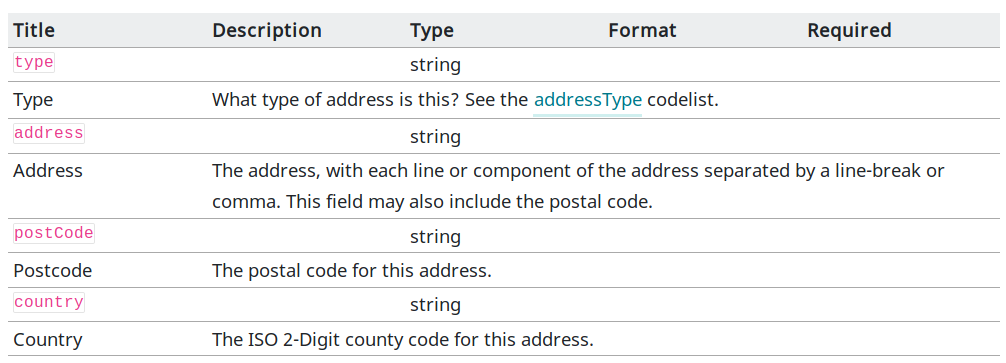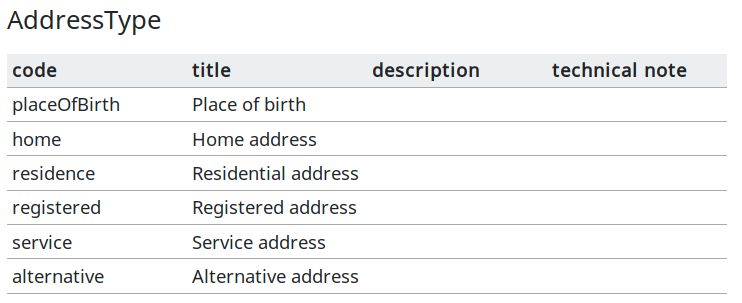bods-dev-handbook
BODS Style Guide
This style guide is implemented as of BODS 0.4. It can be used to guide editing and content writing.
Common Conventions
Readability
We try to write clear, concise documentation, using plain English where possible.
These tools can help with this:
Spelling
Use English spelling:
- ‘organisation’ not ‘organization’
- ‘standardised’ not ‘standardized’
- ‘modelling’ not ‘modeling’
Word choice
- use ‘person’ instead of using ‘individual’ as a noun. You can use ‘natural person’ to avoid confusion with ‘legal person’
- use ‘legal entity,’ ‘legal person’ or specific descriptors like ‘registered company’ to describe entities with legal personality
- use ‘legal arrangement’ or specific descriptors like ‘trust’ to describe legal arrangements
- use people instead of persons (unless using specific phrases like natural persons)
- ‘changelog’ not ‘change-log,’ ‘change log,’ or ‘changeLog’
- ‘codelist’ not ‘code-list,’ ‘code list’ or ‘codeList’
- ‘politically exposed’ not ‘politically-exposed’
- ‘free text’ not ‘free-text’
- refer to JSON objects as ‘objects’ not ‘blocks’ or ‘components’
- use ‘schema’ to refer to the JSON schema in isolation
- use ‘standard’ to refer to the who standard (the JSON schema and all other requirements combined)
Grammar
- do not use constructions like “person(s)”, “the supplier (or suppliers)”, or ‘one or more persons’. The plural is fine, “persons”
- avoid using and/or, where needed you can use “or both” (e.g. ownership, control, or both
- use ‘and’ not ‘&’ or ‘+’
- abbreviations such as “e.g.”, “i.e.”, and “etc.” need full stops, but prefixes and acronyms (for example, “Dr Jane Goodall”, “BODS”) do not
Acronyms
Don’t assume everyone is aware of common acronyms. The first time an acronym is used in a property description (schema) or on a page (docs) the full term should be used, followed the by the acronym in parentheses (e.g. “whether the person described by this statement has the status of politically exposed person (PEP).”)
Make all letters in acronyms uppercase (PEP not Pep).
These acronyms are commonly used in the documentation:
- ‘BODS’ for ‘Beneficial Ownership Data Standard’
- ‘PEP’ is used for ‘Politically Exposed Persons’
Normative Statements
Normative statements MUST:
- be constructed using the keywords defined in RFC2119
- have capitalised keywords to distinguish from those words being used in a non-normative statement
Non-normative statements:
- MAY use the same keywords as normative statements
- MUST format normative keywords in lower case (e.g ‘Implementers should be aware that future changes are anticipated’)
Schema style guide
Duplication
Avoid multiple representations of the same fact where possible. A user should have a single way of answering a given question. Having multiple representations of the same fact also introduces the possibility of inconsistent values.
Names and titles
‘Names’ refer to JSON keys, codelists and codelist entries used in the schema.
Names:
- are formatted using camelCase (e.g ‘interestedParty’, ‘entityType’, ‘identifiers’)
- do not contain spaces or punctuation
- are not translated into languages other than English
‘Titles’ are the way that a name is referred to in the documentation. (e.g ‘Use the Statement Fragment Pointer to describe…’)
Titles:
- have all words capitalised
- have spaces between words
- are translated into languages other than English
Field and code descriptions
The first sentence of a description should:
- be a statement not a question. E.g for beneficialOwnershipOrControl - ‘Whether the statement asserts this relationship as beneficial ownership or control’ not ‘Does this statement assert this as a beneficial ownership or control interest?’
- be written in a neutral voice, not for a specific audience. E.g for ‘foundingDate’ - ‘When the entity was founded, in ISO 8601 format’ not ‘When the entity was founded, please provide this in ISO 8601 format’
Subsequent sentences may provide information or guidance to assist publishers to use the field effectively or users to interpret the field effectively. Guidance sentences should be grounded in clear user needs and implementation experience of common pitfalls or errors.
Descriptions with a link to a codelist should be phrased as - ‘<description>, using the <name> codelist.’
Descriptions should also:
- refer to names using backquotes E.g. “`id` is required”
- refer to values, whether example free text strings or values from a codelist, using single quotes. E.g. “the given name for Johann Sebastian Bach is ‘Johann Sebastian’”
- use plain text only, without markup (eg. no [Markdown](https://en.wikipedia.org/wiki/Markdown) or similar syntax)
- place URLs in brackets by the appropriate word or phrase or at the end of the sentence
Descriptions should not:
- include duplications of the codelist as part of the description
- link to external websites
- only restate the title or name E.g ‘Address type’ - ‘The address type’
- explicity state whether a field is required or optional (this is indicated by an asterisk)
- declare the type of the field (this is indicated above the description)
Assuming the rest of the guidance is followed, it is recommended to start the description with:
- “Whether”, for a boolean field.
- “The” with a plural noun phrase, for the description of an array of strings.
Documentation style guide
Headings and subheadings
Use sentence case for headings and subheadings.
In RST:
- page titles are indicated by underlining with =
- headings are indicated by underlining with -
- subheadings are indicated by underlining with ^
Bulleted lists
When using bulleted lists you should:
- start with a lead in line, followed by a colon
- use lower case at the start of each bullet
- not put semicolons or full stops at the end of bullets
- not put or/and at the end of bullets
- try to have one sentence per bullet
Referring to JSON objects
When referring to objects in the data model, capitalise them. For example, when writing about interests:
- capitalise when you’re referring to the JSON object (e.g. …each Interest in the Statement should have a
directOrIndirectvalue of ‘indirect’…) - don’t capitalise when referring to interests as a general concept (e.g. A beneficial owner may have a number of interests in a company…)
Restructured text files
restructuredText (.rst) files are used to document BODS.
-
Properties should be referred to by their property name (not title) and marked up as ``propertyName``. This can be used to refer to the property and its value. Or it can be used as a shorthand for the property value.
-
Nested properties should be referred to using a period between the levels of nesting (e.g. ‘publicationDetails.publicationDate’ not ‘publicationDetails/publicationDate’). When referring to a nested array use numbers to indicate the position of the object within the array (e.g. ‘interests.0.type: settlor, interests.1.type: trustee’)
-
Schema objects should be referred to by their title, (e.g. ‘the Interested Party object has a number of required properties’, ‘The details of the company are entered into an Entity Statement’)
Embeddeding schema objects
We use various plugins to embed schema and codelist elements in dynamic ways.
JSONValue (in the docs conf.py) to pull out the value of one key in the JSON, e.g.:
.. json-value:: ../_build_schema/components.json
:pointer: /definitions/Address/description

JSONSchema (a Sphinx extension) to make a table of multiple key-value pairs from the JSON, e.g.:
.. jsonschema:: ../_build_schema/components.json
:pointer: /definitions/Address
:externallinks: {"type":{"url":"#addresstype","text":"Codelists"}}

CSVTable (a builtin Sphinx directive) to make a table from codelist csv files, e.g.:
.. csv-table::
:header-rows: 1
:class: codelist-table
:file: ../_build_schema/codelists/addressType.csv

Reference Page
The reference page should be ordered:
- objects
- codelists
These sections should be ordered alphabetically.
Use titles not names for the subheadings of the objects and codelists sections.
The Reference page in the schema makes extensive use of the jsonschema Sphinx directive which ODSC maintains.
These directives are used frequently:
:externallinks::allowexternalrefs::collapse:
Anchor links .. _link-anchor allow a section to be linked elsewhere in the docs <link-anchor>. Link anchors must be maintained to prevent broken links. Broken anchor links may generate this warning when building the docs WARNING: 'any' reference target not found: link-anchor
Diagrams
See diagram creation for advice on how to create diagrams.
The BOVS template should be used as the reference point for icons.
Technical diagrams often require representations of statements. For this:
- place a rectangle to the right of the icon or ownership line the statement relates to with background colour #efefefff (light grey 2 in Google Draw) and a black outline
- the type of statement should be written directly above the rectangle
- inside the box include only the essential key:value pairs for the point you are illustrating
Font choice:
- use Arial for all text in diagrams
- as a guideline you could use font size 10 for icon labels (‘Person A’, ‘Company A’), font size 9 for text inside the statement rectangle (‘entityType: registeredEntity), and font size 8 for the statement label (‘entity stament’, ‘person statement’)
Text alignment:
- icon labels should be placed underneath icons, centred and aligned to the centre of the icon
- statement labels should be aligned above the statement rectangle, aligned to the right and the right edge should be at the right edge of the rectangle
- text inside the statement rectangle should be left aligned and placed close to the left edge of the rectangle with a small gap, the text should be centred on the horizontal axis of the rectangle.